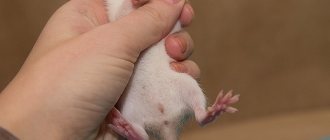From time to time, when I walk with my ferret in a specialized park, I hear a conversation between two breeders who are actively discussing one question: “ Who is better, a male or a female ferret?” ". Debates can sometimes last several tens of minutes, but they still fail to come to a logical conclusion, as they say, “every sandpiper praises his swamp.” Perhaps they just like to talk about this topic, and they are having fun, without any intentions of offending each other, especially since I often see them together, apparently old friends. Of course, it’s stupid to argue which of them is better, a female or a male ferret, but there are still some visual differences in behavior and character.
Determining the sex of a ferret
Sexual demorphism in ferrets is pronounced. Males are larger, sometimes almost twice as large, and stockier. They have a flat muzzle and thick, strong paws. In order to distinguish young animals by gender when purchasing, you need to turn the animal over on its back and carefully examine the abdomen. Males have a tubercle quite far from the tail. Females have only an anus under their tail.
It is, of course, easier to determine sex when the animal has reached adulthood. Males weigh up to 2.5 kg, females up to 1 kg. Males eat a lot, mark their territory with urine and feces, and smell strongly. For these reasons, breeders strongly advise that ferrets be neutered between 10 and 12 months of age.
Sexually mature females are slender and graceful. Their muzzle is longer, and their limbs are thinner and slightly longer. Girls eat less and often hide food in reserve, setting up a hiding place in the corner of a cage or apartment. They are more cautious and less amenable to taming.
Is she a ferret or is he a ferret: choose the gender of your pet
After you have decided what kind of pet to get, a new question and a new task arises: a boy or a girl? Females and males always differ: some of them are calmer, kinder, while others, on the contrary, are active and aggressive. We decided to tell you about all the pros and cons of ferrets of both sexes, and then the choice is yours.
Female
1. Independent, but more trainable than the male. Getting her used to the litter tray is not that difficult if you devote enough time to this issue.
2. The behavior of each female is individual, but basically most of the time she explores the territory of her cage.
3. Females are less attached to their owners, they are more interested in their personal space.
4. They cope with a change of environment without stress. They will also take the change of owner calmly.
5. Females are more active, restless and playful than males. The world around them constantly attracts them, they are interested in everything around them.
6. Girls are considered less dangerous to children.
7. It is recommended to have females for those who have no experience in keeping ferrets.
8. The main issues that the girl’s owner will have to decide are sterilization or obtaining offspring. Ferrets cannot come out of heat on their own.
9. Females, as a rule, successfully reproduce annually for 3-4 years. You can breed a female two weeks after the start of estrus. When choosing a pair, you should stick to the same color from both manufacturers.
10. A pregnant female requires more attention. She eats, drinks and sleeps more often. Ferrets actively shed during this time, but their behavior calms down, becomes more cautious and less playful. At the beginning of estrus, the female must be given vitamins. Calcium, phosphorus, vitamins, and yeast are added to the feed.
11. The female’s pregnancy lasts 40-45 days.
Male
1. During adolescence, males will behave violently, trying to dominate their owner. Later they become calmer and even lazy.
2. Males are more attached to the owner than females. Some can even sleep in their owner's arms.
3. It is much more difficult to train a male ferret to use a litter box; girls are more accommodating in this regard. In the matter of his upbringing, the owner will have to show more rigor and perseverance in order to achieve the desired results.
4. Uncastrated males will be active, noisy, restless and even aggressive. They constantly mark their territory (fraught with a strong pungent odor), lose their appetite and are constantly looking for a female.
5. If you do not want to breed small ferrets, then it is best to castrate the male. Castration period: 6-8 months.
6. The ferrets' rut lasts from March to September. Ferrets need to be introduced to the male's territory. The mating process occurs noisily, with squeals and fights.
Why do people prefer ferrets?
This is a funny animal that is not deprived of its charm and beauty. He can be trained to go to the litter box, just like a cat. At the same time, it is a devoted pet. You can walk with him on the street, putting a harness on him. It usually does not cause allergies, and it is also difficult to get bored with it. These are independent and intelligent animals that easily get along with other pets.
What gender should I get a ferret?
Male and female ferrets differ greatly in size, proportions, as well as character and behavior.
Males are one and a half to two times larger and heavier than females. The average weight of a male is 1.5-2 kg, although there are animals weighing up to 3 kg. The muzzle of males is wider and flatter than that of females, and the fur is thicker. A well-groomed large male in winter fur looks like a miniature bear.
Compared to males, females look much more elegant and graceful. They are sharper-faced, more flexible and agile. The average weight of females is from 800 g to 1 kg.
An interesting pattern has been noticed: as a rule, males are most often attracted to females, while females, on the contrary, are attracted to males.
Male and female ferrets have different personalities, behaviors, and habits. Females are more agile, they are more dynamic and curious than males. A female can rarely sit in one place for more than 3-4 seconds: constant exploration of the territory takes up a huge part of the time in her life. Therefore, the behavior of females is more varied and interesting.
This character of females results in the fact that, compared to males, they are more independent and “on their own.” They are less attached to humans and more attached to their territory. Due to the fact that in nature females raise puppies without the help of males, females are characterized by a more flexible and developed intelligence. They are more intelligent, more trainable and much more cunning than males.
Males, on the contrary, are calmer, become more attached to their owner, and many of them are not averse to being held in their arms. The average male is inferior in intelligence to a female, but this does not mean that he is stupid. It's just that males' minds work a little differently.
Generally speaking, females are more interested in the world around them than the owner, and males - vice versa.
All of the above are just general character traits that may not be inherent in a particular animal. There are females who are very attached to the owner and constantly follow on his heels, and males who are more interested in the world around them than in humans.
Whom to choose? Who is easier to keep: a male or a female? There is no clear answer to this question. Each gender has its own advantages and disadvantages, knowing which, you can decide for yourself which one is right for you.
Females are more trainable and more obedient than males, so it is much easier to train them to use a tray. Females are safer for children. If a person does not have experience keeping ferrets, he is often recommended to get a female.
The main problem associated with females is the need to either get offspring from them or castrate them. The fact is that most females cannot come out of estrus on their own. Prolonged estrus leads to hormonal changes, and within a fairly short time can result in the death of the animal.
It is more difficult to train a male to use a litter box than a female, and during adolescence (from 3-4 to 7-8 months) he will try to dominate the owner (as do maturing dog puppies). In raising a male, one must show more perseverance and firmness than in the case of a female, and devote more time to communicating with the animal. Males also need to be castrated: the fact is that during the rut, males begin to mark the territory with urine marks, which have a strong unpleasant odor. In addition, males become more aggressive and disobedient.
If you want a companion who loves you and waits for you to return when you go away, a male is your best bet. If you prefer an independent animal that “walks on its own”, but at the same time contacts and communicates (though only on its own initiative) with you, get a female.
Source
Is she a ferret or is he a ferret: choose the gender of your pet
After you have decided what kind of pet to get, a new question and a new task arises: a boy or a girl? Females and males always differ: some of them are calmer, kinder, while others, on the contrary, are active and aggressive. We decided to tell you about all the pros and cons of ferrets of both sexes, and then the choice is yours.
Female
1. Independent, but more trainable than the male. Getting her used to the litter tray is not that difficult if you devote enough time to this issue.
2. The behavior of each female is individual, but basically most of the time she explores the territory of her cage.
3. Females are less attached to their owners, they are more interested in their personal space.
4. They cope with a change of environment without stress. They will also take the change of owner calmly.
5. Females are more active, restless and playful than males. The world around them constantly attracts them, they are interested in everything around them.
6. Girls are considered less dangerous to children.
7. It is recommended to have females for those who have no experience in keeping ferrets.
8. The main issues that the girl’s owner will have to decide are sterilization or obtaining offspring. Ferrets cannot come out of heat on their own.
9. Females, as a rule, successfully reproduce annually for 3-4 years. You can breed a female two weeks after the start of estrus. When choosing a pair, you should stick to the same color from both manufacturers.
10. A pregnant female requires more attention. She eats, drinks and sleeps more often. Ferrets actively shed during this time, but their behavior calms down, becomes more cautious and less playful. At the beginning of estrus, the female must be given vitamins. Calcium, phosphorus, vitamins, and yeast are added to the feed.
11. The female’s pregnancy lasts 40-45 days.
Male
1. During adolescence, males will behave violently, trying to dominate their owner. Later they become calmer and even lazy.
2. Males are more attached to the owner than females. Some can even sleep in their owner's arms.
3. It is much more difficult to train a male ferret to use a litter box; girls are more accommodating in this regard. In the matter of his upbringing, the owner will have to show more rigor and perseverance in order to achieve the desired results.
4. Uncastrated males will be active, noisy, restless and even aggressive. They constantly mark their territory (fraught with a strong pungent odor), lose their appetite and are constantly looking for a female.
5. If you do not want to breed small ferrets, then it is best to castrate the male. Castration period: 6-8 months.
6. The ferrets' rut lasts from March to September. Ferrets need to be introduced to the male's territory. The mating process occurs noisily, with squeals and fights.
Why do people prefer ferrets?
This is a funny animal that is not deprived of its charm and beauty. He can be trained to go to the litter box, just like a cat. At the same time, it is a devoted pet. You can walk with him on the street, putting a harness on him. It usually does not cause allergies, and it is also difficult to get bored with it. These are independent and intelligent animals that easily get along with other pets.
What kind of troubles can you face with a ferret?
Source
Buying a ferret - girl or boy
When you come to an online pet supply store to buy a ferret, you, of course, rely on your heart, that is, which one looks at you and whose eyes you like best, take it. I want to tell you about the differences in behavior between female and male ferrets. Girls - they have an iron, one might say slightly nasty character. A female ferret will never allow you to dominate her. When buying any animal, not just a ferret, you will have to immediately set the record straight and explain to the animal that you are the boss of the house. It will be difficult for you to find a common language with a female; you are unlikely to convince her that she is not the mistress of the house. She is less tame than the boy. Try to squeeze it more and more at once to make it at least a little more manual. It’s not a fact that you will succeed, but you can try. The girl's insidious character is often combined with her kindness in games; she will never bite you very hard, and will always be affectionate with children and other animals. A girl is correctly and outwardly different from a boy, her face is prettier. The female ferret is left to her own devices, she is not bored alone and can run around for hours and look for something, eventually falling asleep in splendid isolation. A man is a man, you will immediately see a male ferret from the crowd, he has a serious expression on his muzzle and is usually larger. True, the size of the animal depends on the age at which you castrated it.
Male ferrets are more attached to their owner. They get used to hands more often than girls, can sleep for hours on their owner’s lap, are more affectionate, and can even accept ferret food from human hands. As for aggression, the boy will not allow himself to be offended. When communicating with strangers, the bite can be very painful.
To summarize, it is still easier to raise a boy than a girl, but girls are usually prettier and nicer, and the choice is yours.
Source
Boy
The male ferret's muzzle is slightly flattened, his appearance is serious and brutal, and his size is impressive.
It seems that if you approach him and extend your hand, he will definitely bite it. In reality, this is not the case. Males have a balanced character, are friendly and flexible, they love human hands and communication with their owner. They cannot be alone for a long time, so whenever they are bored, they will remind you of themselves by biting them on the heel (mine did exactly that).
Males love when their owner plays with them; they like to sleep on their laps or chest. But, as befits any male, he will try to get the better of you, in a word, dominate, so you will have to show who’s boss. Everything that you forbid him will only provoke and anger him.
In addition, boys are larger in size. They have thicker and softer fur, and in winter they generally look like clumsy teddy bears. Males eat more, which is what men are supposed to eat, so adult ferrets take on a well-fed appearance and do not care about their figure.
In addition, the male will constantly mark all corners of your apartment with urine and sometimes fecal marks throughout the entire rutting period. The smell, both from him and in the apartment, will be terrible. Do you need it? Therefore, if you do not consider your male as a sire, then castration is mandatory.
Ferret
The ferret is a member of the weasel family. There are 3 types of animals in nature: forest, steppe and American. Domestic ferrets are placed in a separate group, ferrets.
Individuals of this group are domesticated animals of forest and steppe species. Breeders have developed many varieties of ferrets, which differ in the shade of their fur.
Is it possible to keep animals in an apartment? How to care for a ferret at home?
Advantages and disadvantages
Exotic lovers keep ferrets as pets in an apartment or in a private house. The animals are unusual, have decorative colored fur, and look very pretty.
According to the description of experts, the size of the ferrets is 40 cm. They weigh 1.5-2 kg. You can get a large male or female that does not grow more than 30 cm. To breed ferrets, they buy a boy and a girl.
These are predators. In nature, they feed on small rodents. They are active at night, but domestic ferrets can also be active during the day.
In addition to natural colors, breeders offer sable, silver, and chocolate-colored animals. You can buy Dalmatians, white, black individuals.
Individuals of the champagne, blaze, and cinnamon color look unusual. How do ferrets behave at home? What pros and cons do animalists note on forums?
The fret attracts not only its appearance, but also its behavior. She is very nimble and is constantly on the move. The animals are inquisitive and love to explore the territory in which they live.
Ferrets are interesting to watch and participate in their active life. This point is considered one of the advantages of keeping a pet ferret. Main advantages:
The main disadvantage of the ferret is that not all keepers can withstand its activity. A ferret should not be left unattended in an apartment. He will explore his territory.
He will get into a closet, a trash container, an open washing machine, under a sofa, or into a shopping bag or handbag. Moreover, the animal is very economical.
The animal takes the objects it likes and hides it in secluded places. All jewelry, cosmetics, hygiene products, dishes, and stationery should be kept in closed boxes.
Another disadvantage of keeping a ferret at home is the specific smell that comes from it. The ferret has glands under its tail.
If the house has a stove or fireplace, then before lighting it, be sure to check whether there are ferrets in the firebox or in the ventilation pipe. They like to crawl into places that look like burrows. The stove and fireplace must be closed with a damper or screen.
If a pet is stressed, the glands begin to produce an unpleasant odor.
On the forums, keepers say that no smell will come from the animal if it is kept in comfortable conditions, does not irritate your pet, and does not create stressful situations for them.
A ferret, like a pet, requires attention. Like any pet, it needs to be looked after.
A large cage is set up for him, walks are organized, and a feeding regime is observed. Animals are shown to a veterinarian once a year. They get vaccinated.
Whether it is worth getting a ferret, everyone decides for themselves, but it is necessary to analyze all the disadvantages of this acquisition.
Girl
Females have a more elongated and prettier muzzle, they are slender and graceful, as befits girls.
They are smaller in size than males, eat less and never overeat, as if they care about their figure. The female ferret is smarter, more active, more affectionate, quick-witted and cunning, due to the fact that in nature she is engaged in raising and raising offspring independently. She accumulates everything that can be useful in her household in her hiding place, which can be located in any secluded corner of the apartment.
The coat of females is less lush, coarse and dense, so in the winter season they remain slender.
But the female is less attached to the owner. She will not be bored, even if the owner does not pay attention and does not play with her. She will go about her business, explore the territory again, rummage through your laundry, check the contents of your purse. Females do not like to sit on their hands, and in general they cannot sit quietly in one place for a single minute.
Getting to know a stranger may not be in a friendly atmosphere, the female may bite, so before you give her into the hands of a stranger, make sure that your girl has no aggression towards him.
If you have a female ferret, be prepared to visit the veterinarian for sterilization. They cannot come out of heat on their own, which can lead to dehydration, hormonal imbalance and, as a result, the death of the animal. Take this into account!
Source
Place to live
A ferret at home can live on average 10 years. Individuals that live up to 15 years are considered long-livers. It is necessary to prepare a place for the animal where it will live.
It could be a cage, a house, an aviary, a display case. The home should be spacious and made of safe material:
Enclosures and display cases are best suited for animals. In a ferret's apartment, a wardrobe is often remodeled, in which several floors are arranged.
A pet needs fresh air, so ventilation must be provided in the display case.
The place for the ferret is equipped with a house where the animal rests. The animal loves to sleep in a hammock. For games, they install a running wheel, shelves, labyrinths, and objects that imitate holes.
The pet is toilet trained. To do this, install a tray with cat litter.
Caring for a ferret at home requires some physical effort. The cage must be cleaned once a week. The toilet is changed daily.
Keeping a ferret at home involves walking in the fresh air. A harness and a long leash are used for the animal.
These devices are necessary to control the activity of the animal. The animal must be accustomed to the street and to wearing a harness. Otherwise he will experience stress.
What to feed?
Ferrets are not picky about food. At home, they will eat everything that is offered to them, but the quality of the food must be monitored. Special food has been created for exotic animals.
It is nutritionally balanced. A vitamin and mineral complex has been added to it.
Some animalists prefer to prepare their pet’s diet themselves:
Water must be freely available. The drinking bowl is washed daily with soda. The water is changed. For drinking, use filtered water at room temperature.
Health
When keeping a pet ferret, you need to collect a first aid kit. In addition to antiseptics and dressings, it is recommended to include Vaseline.
It is fed to the animal along with food for constipation or vomiting. The kit should include first aid medications:
Diseases in domestic ferrets are often associated with improper feeding. Experts do not recommend treating animals yourself. It is necessary to contact doctors.
Keeping a ferret is difficult, but any pet requires care. You can get a lot of positive emotions from a ferret.
Source










